Memoir
Into Each Life a Little Cake Must Fall: Lessons from a Cake-Tastrophe

This is the tale of an epic Cake-Fail.
It felt, at the time, like an absolute disaster.
Real disasters, like earthquakes, tornadoes, wars and disease put this story in perspective.
But in our day-to day lives, there are experiences that feel like disasters at the time; experiences in which survival adrenaline is at work; in which you encounter failure a dozen ways over. Life itself may not be at stake, but it can be difficult persuading your mind of that fact when faced with the crushing of plans, or a spectacular “miss”when your results are at stake. Your results and failures, of course, never affect just you, but a whole host of people either waiting for your promised outcome, or cleaning up after you when something goes wrong.
Whether your flop happens in a single moment or in a slow build-up over years, when it does hit, all you can see is the ruin—a crisis to deal with, and no-way out.
In thinking about some of the more difficult challenges I’ve been facing recently, I found myself ruminating on that experience, so long ago now…
It’s Not Always a “Piece of Cake”…
It was in the early 90’s, during a short time when I was mostly a stay-at-home mom. Unable to sit around, and with my corporate travel restricted due to my young baby, I had a stint as a high-end cake decorator—pastry school, seminars—the works.
I trained with some of the greats, whose names are known to all the famous cake people on TV today. It was before the Food Network and YouTube turned spectacular cakes into a competitive sport, as well as into a skill accessible to anyone with a computer. Back then it was still a rarified world of buttercream and gum paste specialists, and my own presentations were replete with “ooh’s and ah’s” from admirers when I produced my floral fantasies in sugar, the likes of which few people in that era had ever seen.

Through a caterer, I got an order for a cake for a garden wedding on an estate in Greenwich, CT. The couple were very specific about the kind of cake they wanted: poppy seed with raspberry filling. I went to my baker, Manfred, to put in the order. He was a Viennese pastry whiz who sold me delicious “blanks” (un-iced cakes) from his shop. I conveyed the rather unusual flavor request, and he nodded. In my mind, I was envisioning a thin spread of raspberry jam between several torted layers of each cake. Torting, or having many layers of filling in each cake, is part of the art of fine pastry, and I left the execution of same in his capable Viennese hands.
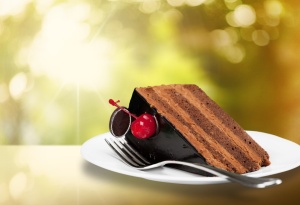
Two solid weeks were spent working on the elaborate buttercream flowers that would go on the cake. There was no room for food in either my fridge or my freezer; the kitchen was a mass of colored containers of icing and Tupperware containers of frozen buttercream roses, sweet peas, bleeding hearts, daffodils and my specialty: multi-colored pansies.
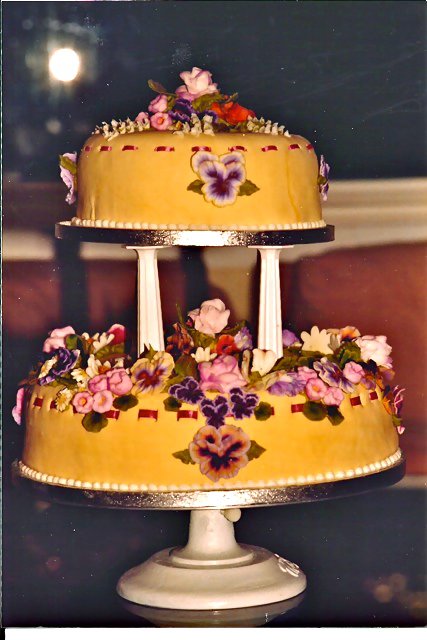
When I picked up the “blank” cakes the day before the wedding, I saw that instead of a thin layer of raspberry jam, Manfred had created each cake alternating multiple 1/2″ layers of raspberry mousse with an equal proportion of cake. Not what I’d thought, but, hey.
Ok, then. I set to work.
Fourteen hours of decorating later, after pounding in the requisite dowels and structural supports that go into the architecture of wedding cakes; after endless intricate and meticulous buttercream Cornelli work: after icing flower placements and finishing flourishes, at 10:30 on the morning of the wedding I loaded the cake into the back of my minivan for delivery. Because my daughter was hardly more than a baby, she got to come on the delivery run too, as did my husband, acting as driver and loyal supporter and helper.
Did I mention it was a hot, humid summer day?
As my husband slowly pulled the car about five feet down the sloped driveway, he glanced in the rear view mirror and said: “Oh Shit!”
This was not a good sound.
I ran around to the back, lifted the tailgate, and stared at a fallen, soggy mass of stair-stepped layers. The mere vibration of the car had been enough to coax every torted layer to slip past all the internal supports and external baffling, The gelatinous texture of the filling had provided a nice slippery surface so that with the slightest encouragement, the cake layers had gone for a ride on a confectionary Slip ‘n’ Slide, leaving a disastrous mess of mousse and the pillaged wreck of cake and buttercream.
I can still feel the shock and disbelief that simply did not register at first. I don’t like to think about that moment, even 25 years later.
We jumped back into the car and drove down the hill to the bakery. I was in total panic. Manfred came out to the car and said: “Oh, Shit! Oh Shit!”
He was followed by his wife (the “bad cop” in the relationship) harping loudly: “It’s not our fault! It’s not our fault!”
Manfred shook his head ruefully and then looked at his watch: 11:00 a.m.
“I have some frozen layers in stock. Give me two hours. I can cover them with fondant—then you can just do the flowers,” he offered.
Fortunately, I always made many more flowers than needed in case of breakage.
Two hours till pickup of the layers…that gave me…how long?
The wedding was at 6:00 p.m.. I had to deliver it well before then. I’d have two, maybe three hours to pull it together. At most.

Now I had to call the client. We drove back home, because this was before cellphones. My heart was racing as I dialed the bride’s number.
The father of the bride answered.
“I have bad news and good news,” I began. “The bad news is that the wedding cake I just spent 14 hours decorating collapsed in my car. The good news is that you will have a wedding cake.”
I held my breath, waiting for his response.
The father said, in a voice full of compassionate concern: “Oh, how terrible for you!”
What? Yes, that’s what he said. He paused and thought.
“I think I can buy you a little extra window of time,” he said, with the satisfied air of someone who had just solved a puzzle, “The cocktail hour is at 6:30-7:30 p.m. Why don’t you come then, after the ceremony?”
I could have cried with gratitude. In fact, maybe I did.
While my husband scooped the buttercream disaster out of the back of the van with cardboard shovels that he concocted, I called my sister-in-law to beg her to please come and watch my daughter so I could concentrate on the Herculean task at hand.
She later told me she hadn’t heard my voice sound like that since my mother had died a few years before.
I got to work filling pastry bags and organizing the remaining flowers, entirely re-designing the cake in my head. I had no idea what size layers Manfred had on hand. Fortunately, one layer had escaped the “car”-nage—the small top layer that would rest separately on elevated crystal pillars. One less layer to worry about, I thought, even if it would look slightly different than the rest.
My husband picked up the frozen cakes from Manfred. It’s worth noting that putting fondant over frozen layers is risky, as the fondant will sweat with moisture. The fondant could tear, or the flowers get runny, or who knows what else. I just hoped if that was going to happen, it would take place after the cake was safely at the client’s and I was nowhere in sight.
At 6:30, I pulled my minivan into the driveway of the home-wedding-in-a-mansion in Greenwich. I could see the bride and the guests with their canapes and cocktails under a tent in the distance. The caterer came running out to meet me, threw her arms around me and gave me a huge hug, like a war veteran meeting another battle-scarred soldier. Together, we got the cake settled onto its display table in the house, put the top layer with the bride & groom decoration on top, hugged again and I left. The fact that it wasn’t poppy seed and raspberry seemed to matter not at all.
My husband and I had a dinner out, including a few stiff drinks—and neither one of us was a drinker.
Some time not that long after, my corporate career came calling again, and I laid my pastry bags down for good.
Things I Learned from the Great Cake-Tastrophe
People Recognize that Shit Happens. They Can be Surprisingly Kind and Generous. Also, Looking Back Through the Rear View Mirror, Grace Abounded.
That Manfred had extra cake layers in the freezer, of a wedding cake size— that alone was grace. Otherwise,who knows what I’d have done…I might have had to stack up a bunch of cookies on a plate and plunk a bride and groom on top.
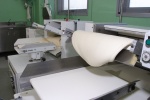
Manfred also had a commercial sheeter (a machine that can roll out large amounts of dough or fondant in just a few passes). I could never have covered three large cakes by hand in that time, if I’d had the fondant in my supplies—which of course, I didn’t. He didn’t have to offer his help, but he did. In the middle of a busy workday and took his time to bail me out right now. When I later tried to reimburse him for the extra cakes, he told me to forget it.
I was also extremely grateful that it was the bride’s father who picked up the phone, because had it been the mother-of-the-bride, or the bride herself, it could much more easily have been a very different story. (I refer you to any episode of Bridezillas for potential reactions.)

The father was not only cool in a crisis, he was kind. His approach to the news was that it was just another thing to deal with, and everything has a solution. He took in the whole picture, not just how he or his daughter were affected. Miraculously, he put himself in my shoes and didn’t make me wrong. He had an ease with the problem-solving and came up with a solution. I was left with the feeling that this quality is probably what made him the kind of businessman who could afford a mansion in Greenwich. This was both Grace and Kindness in spades.
I offered the bridal couple a compensatory anniversary cake for the fact that they had not gotten their flavor request. They never asked for it. They could easily have asked for a refund, or asked me to fulfill on my free cake, but they never did.

My husband did whatever was necessary in the background without asking about it, dropping whatever else he had in mind for his weekend. My sister-in-law dropped all her plans to come babysit the whole day, and babysitting was not her favorite thing. In a crisis, the reinforcements rallied.
When you share a failure story, you find others have trod the same path. That’s often what makes them compassionate, especially if something similar has ever happened to them. War veterans stick together.
Manfred, a master baker, told me in the aftermath that this is exactly why he hated doing wedding cakes; he’d had enough of his own disasters. Owing to the precarious nature of wedding cake transport, he had evolved the method he had done with me: he left the layers frozen, covered them with fondant at the last minute, put a few simple roses on the cake, drove like hell to the wedding location and prayed.
The caterer at the wedding who ran out to meet me with open arms wasn’t angry, or sniping about how I’d let her down or how her client weren’t properly served. She approached me as someone who has seen her share of disasters and pulled it out of the hat at the last moment herself. That too surprised me no end.
Even Masters Get the Blues

Some time after this, I shared my Cake-Fail story with Chef Albert Kumin, with whom I studied at Vie de France Pastry School. Chef Kumin was a former White House Pastry Chef, the founding pastry chef of Windows on the World, a legendary chocolatier, and at the time, one of the few people preserving and teaching the art of pulled and blown sugar. (He also bore a strong resemblance to the Swedish Chef from the Muppets.) When I told him what had happened, he shook his head and said: “Once I was in a big competition in Canada. I’d worked forever on four-foot tall intricate woven sugar baskets with blown sugar fruit. They were so tall and heavy it took a few people to lift them. When I got to the site, I saw they had to be transported through a revolving door.” He shook his head again, sighing ruefully. “We did our best, but, the whole thing shattered in an instant.”
(Anyone who has watched Cake Challenges on the Food Network knows that transporting a large confection from the work site to exhibition the table just 4 feet away can be the most perilous part of the contest.)
Sometimes, Pressure Yields Great Results
The cake I actually delivered, with three large tiers plus the top layer, was assembled and decorated in less than four hours. In some ways, it looked better than the one I’d slaved over for four times as long. I had learned this as a painter back in art school: the quick impromptu variation dashed off after laboring long hours on some drawing or painting was often better than the one on which so much studied effort had been expended. All the carefulness of the first work gets metabolized by that long study; spontaneity arises from that integrated foundation in a freer, more poetic way.
Epilogue: 25 years later…
I was on a drive with a friend when this old experience flashed though my mind.
I realized that the memory of the Cake Fail came to me because from some perspectives, life can look just like that mess of buttercream and mousse smeared in the back of my car. I know the image came to encourage others, that even when you are looking at a situation to which the only reaction is “Oh, Shit”, a million small and large graces abound. And out of that mess arose an even more wonderful creation, supported by many other hands.
If I wasn’t on a diet, I think I’d have a piece of cake, just about now!
What is YOUR Cake-Tastrophe? Would love to hear from you in the comments!
Share this:
This entry was posted in Healing, Memoir, Spiritual Reflections, Stories from the Journey and tagged Albert Kumin, Cake Decorating, changes, Failure.
Travels with Angel
The folks who make the Voyage-Air folding guitar have an Owner’s Club on their website and I was asked to contribute my experiences. That led to my written reflections on the place that each guitar that’s come into my life represented a place, a time and a memory, and my realization that I had never really selected my own instrument till a turning point that started with a dream. The article is at their website (link below), and I’ve reproduced it here with a few changes, edits and upgrades. Link to the article at the Voyage-Air site: http://www.voyageairguitar.com/owners-club/featured-owner/505
Here’s my expanded article with more pix:

Travels with Angel
Travels with Angel – My Journey to the Voyage-Air
By Rev. Nettie M. Spiwack
Jim Wolcott at Voyage-Air asked me to write a few words about my experiences with their folding guitar, that little marvel of which I was an early adopter.
For a musician, every instrument has its unique place in your history.
One night back in 2001 I had a dream about a guitar. As I came awake, the verses of Jerry Jeff Walker’s “Old Beat Up Guitar” were in my mind:
She traveled with me always, through the alleys and the bars
The songs I sang and the friends I knew were a part of that guitar…
Jerry Jeff called his guitar “Angel,” after someone drew one on the top of it. Finding, losing and then finding her again in his travels features prominently in that song he recorded in 1972, and which I hadn’t thought of in a few decades.
Well, a traveling man has trouble holding on to all he owns
And in those years of traveling that guitar fell by the road
Then one night in New Mexico, I stumbled into a bar
And there lay Angel smiling at me on that old beat up guitar.
The dream was a message. I was about to go out to play music for a retreat in California, and I knew it was time to go find my Angel.
I had played many guitars in my life by that time, but in truth, not one of them had I selected and bought myself.
I started playing folk guitar early, in a wonderful setting that was right out of a cliché. I was nine years old; it was summer at Camp Johnny Appleseed where my mother was working that year in the camp office. With mom’s brown Favilla nylon-string guitar—bought in aspiration of her learning to play it, as my parents were part of the Hootenanny generation—I attended a group class, sitting on a porch in the Catskills and learned Woody Guthrie’s “Rambling Boy” with three whole chords in the key of A.
Mom’s brown Favilla became my guitar, the one I toted around in its cracked chipboard case—a glorified cardboard box, really—to group and then private lessons. Carrying my guitar didn’t represent too many difficulties because first of all, I was young, both the guitar and the case were light, no airplanes were involved, and no one around me then knew anything about humidity control, or if it was wise to take a guitar in a cardboard box on the NYC subways in winter. Soon, renditions of Go Tell Aunt Rhody gave way to the music of the Beatles and James Taylor and Crosby Stills & Nash.
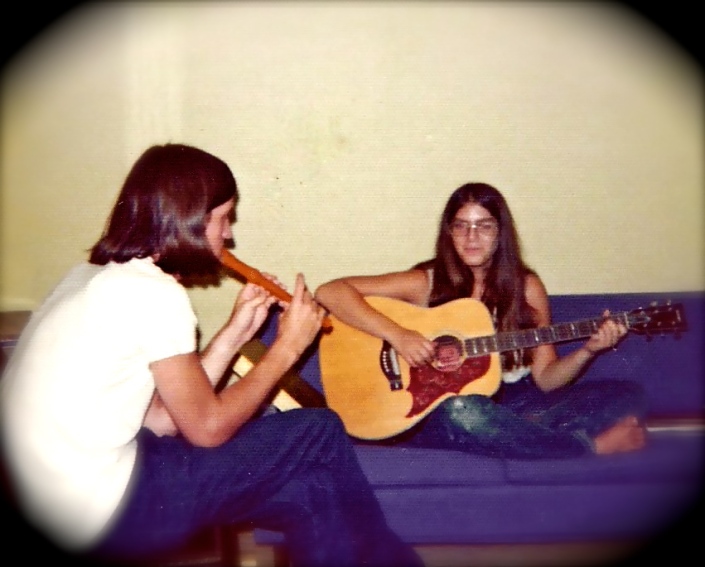
By my years at the High School of Music & Art, I graduated to dad’s huge Harmony Sovereign grand concert. That guitar remains one of the biggest I’ve ever seen to this day. (Quantity, however, should never be confused with quality). Dad really never learned to play more than “You Are My Sunshine,” and turning his guitar over to me caused him no pain. It too, had a chipboard case, was a lot heavier to lug around, and I can still feel the indentation in my hand from the metal rings on the side of the plastic handle.
In the height of the folksinger/songwriter era, numerous other guitars had joined the family as my siblings and I played: my brother’s Guild 12-string, his Gretsch electric, my sister’s La Madrilena classical guitar, and a ¾ version of the same which my mother was determined to, this time, learn to play. (She didn’t.) There was always something to play and often someone playing it. I spent most of those years working out Joni Mitchell’s repertoire and figuring out an occasional open tuning for playing her songs.
I married a man with a Martin D-28, the gold standard of a serious player at the time. (I married up!) He was trying to make it as a performer when we met, though that dream eventually got put aside, and both of us stopped playing for a long stretch. When years later, we parted, he was kind enough to let me keep his Martin on extended loan, for by that time I was starting my career in spiritual music, and guitar was once again front and center in my life.
The D-28 had its legendary sound, not to mention cache, but it had some drawbacks. First, it had tough action, and my hands had a touch of arthritis, which made bar chords on the very rounded neck painful to hold. And then, there was the case. This guitar had the heavy hardshell case with weighty gravitas to match its content. The problem was, I was now in my 40’s and lugging it around to gatherings near and far, and worse, through long airport corridors and onto planes, got harder and harder. Not to mention that my ex was not enthused about my traveling with it.
After that Jerry Jeff dream, I knew it was time to return the Martin to her rightful owner and to go find my own Angel to travel with me.
That first Angel was the Larrivee Mahogany Orchestra Model, which fit me and my hands to a “t”; which I loved and which I lugged with its big heavy hard case through airports, across the USA, and even through India. Angel was later joined by a Taylor 12-string, whose case is so heavy that she’s rarely left my living room.
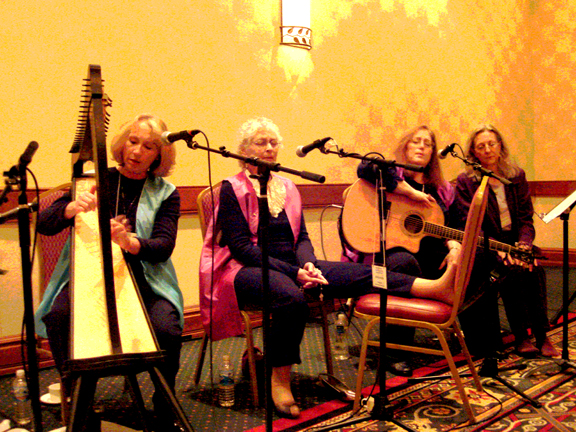
But as Angel and I made our way around over the next eight years I noticed that I wasn’t getting any younger, there’s never a roadie when you need one, the airport corridors got longer, and the airplanes fuller and fuller.
I needed another Angel. One I could travel with but that could still produce worthy sound. I was heading back to Brazil, to a retreat and healing center where I often end up leading music for hundreds of people.
I scoured music stores and the internet for travel guitars. It seemed that not much had changed in the years since I’d last looked. The choices were some sticks with strings, or perhaps a parlor-sized guitar. I had just about settled on a Baby Taylor, when I did one last search. And up popped the aptly named website, TakeYourGuitar.com. When I saw the Voyage-Air’s folding neck, I thought: it’s too good to be true! Then I realized, it’s like rolling luggage: once it was invented, you can’t imagine that no one had figured that one out before.
But how could I buy a guitar off of a website, never having played it or heard it?
Jim Wolcott patiently answered my many questions with great enthusiasm. His passion for the Voyage-Air persuaded me. My family and friends got together and gifted one of the Songwriter series to me for my birthday.
Welcome to the era of Angel II.
I was happily surprised by everything about the guitar…how good it sounded, how easy the action was, how well my hands could manage the (mercifully flatter) neck. And how light it was! Truth be told, I have many purses and totes that are far heavier!
Since 2009, this Voyage-Air guitar has traveled twice to India, several times to Brazil, and on countless trips around the USA. It’s been on every type of airplane, and by zipping off the computer case, I even managed to squeeze it under the seat on a small flight from Madurai to Bangalore when it looked like I might have to check it.
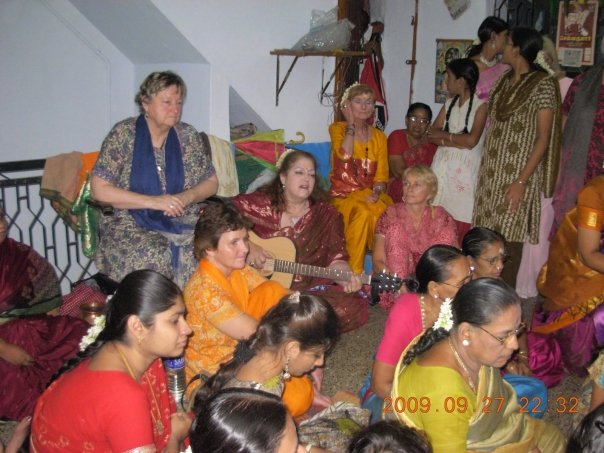
My Voyage-Air never fails to cause a stir. It’s still not widely known, and I’ve even had flight attendants ask me to open it so they could see it!
This summer in Brazil, a classical guitarist almost fell over himself when he saw me fold the neck down. He held it mesmerized, smiling, unable to believe the sound and the engineering.
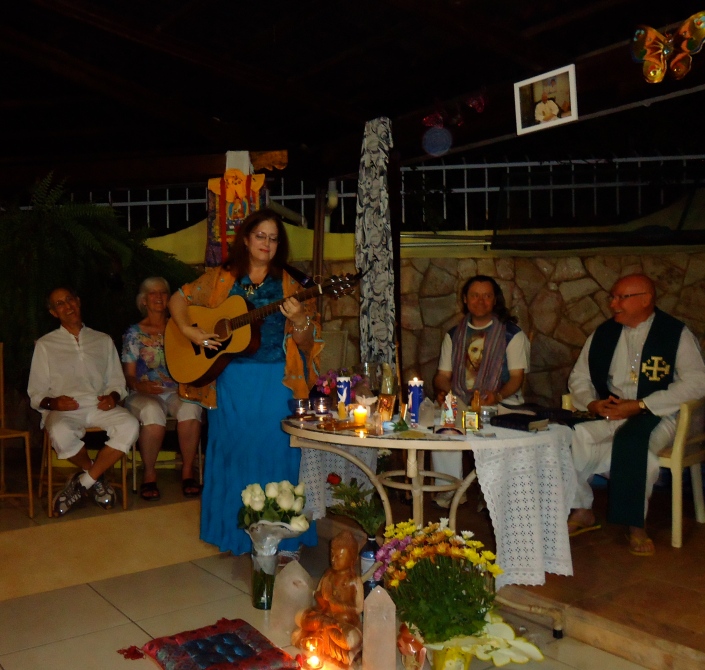
My Larrivee, Angel I, now holds court in my house and steps out once in a while for local gigs. She’s enjoying her retirement, and truth be told, sometimes I look at her wistfully when I’m going on the road, thinking maybe this time I’ll take her. But Angel II always wins out.

Now she travels with me always, through the alleys and the bars
And the friends I make and the songs I write are a part of that guitar,
Some nights it is my pillow resting underneath the stars
Day and night I stay alive with that old beat up guitar.
Well, being a minister and all, I’m neither in alleys nor bars, and I’m more likely to be sleeping on a plane than under the stars. But the spirit of my Angel is the same to me as Jerry Jeff’s was to him, which he captured so beautifully in that song.
Jim and I talk about my upgrading, and maybe at some point I’ll welcome Angel III.
Till then, if you see me at an airport with my Voyage-Air, wave hi!
Rev. Nettie M. Spiwack
Interfaith Minister
about.me/nettiespiwack
revnettie.com
www.nettiespiwack.com
“That Old Beat Up Guitar” by Jerry Jeff Walker, from Jerry Jeff Walker, MCA-37004 1972.
Share this:
This entry was posted in Memoir, Stories from the Journey and tagged Celebrating Life Ministries, guitar, India, music, Soulfyre.
Missing Carla

As the weeks go by, the memory of how she looked at the end is fading. The steroids had rendered her an almost comic cross between Buddha and Uncle Fester. She’d long since lost her hair, and her features had all but disappeared into what was now a swollen and unfamiliar visage. I still see the last moments we were with her, as her eyes went back and forth from one to another of we “sister” friends who had come to say our goodbyes. She had a half smile on her face, at the same time her eyes were thoughtful. It was a quintessential Carla expression. At the time I thought she might have been confused. But Carla was always a thinker who needed time to process things inside.
I believe it was the moment she was really getting it. This was finally it, the road had come to a close. Her gaze caught mine for a long, long moment.
“I have to go?” she half asked, half stated. Then she repeated it, as if to herself: “I have to go.”
“You’ve been a great friend,” I had said to her a few moments before this last declaration.
“It’s been a pleasure,” she replied with her eyes closed, a loving half-smile on her face.
Now that I remember it, I know where I had seen that expression before. It was on my mother’s face, 24 years ago, as I stood at her hospital bedside in her last conscious moments, listening to what were to be her final words. Her closed eyes had signaled: “I’m tired, I have to go.” The half smile as she spoke her last phrase, said everything else.
I was seeing that expression again, on the face of my friend.
The truth was, I hadn’t seen a lot of Carla in the past year or so since she moved from Westport further up the Merritt Parkway to a condo in Stratford. Whereas during our years singing together in our group, Soulfyre, we had seen each other at least once a week, (often at her home), the same disease that had ended our group’s performing days eventually ended Carla’s social life as well. That isolation is where I think she suffered the most.
For a very introverted person, Carla was a real social animal. She enjoyed the bustle of her grown kids coming and going in the chaotic household. She loved having us over for rehearsals and visits at 7 Loren Lane in Westport. She loved being a guest, too. My last good memory of her is her staying over after both Christmas and Passover this year. She made it down here on her own, but needed to stay over rather than drive home.
She loved to stay up late and talk on such occasions. And to watch movies. Carla was a movie-going companion, always up for going to a flick or watching one at home. She had her own little soundtrack: a habit of exhaling a deep audible breath whenever there was a moment of strong emotion on the screen; whether it was happiness or sadness didn’t matter. She was completely unaware of this trait till one day this year I told her about it. It surprised her, and made her both laugh and think about its source. Laughing and thinking, that was Carla.
Carla and I had many great kitchen talks over the years. They followed a pattern. She would share a dilemma of a perception in which she knew she was trapped, and she would plunge headlong into an inquiry into breaking down the limitations of that viewpoint. I would hear that emotional exhale of hers often in such interactions. She was determined to wrest out of me whatever perception would get her another measure of freedom. And many measures she did indeed win.
Carla knew I had something she wanted. She told me so right from the beginning in those words: “whatever you have, I want it,” she laughed. And she worked herself like hell to get it. She remade her interior self more dramatically than anyone I’ve ever known
I want some of what she had too. Her bravery. Her kindness. Her sensitivity to others. Her pitbull quality of holding onto something she wanted to have happen and not letting go. Her absolute fearlessness in facing her future, even if what she was facing would have cowed many a weaker soul—like mine, perhaps.
We didn’t see each other much recently, as I said. So not seeing her now hasn’t felt so strange. Just getting through the real “end” when it was finally, inescapably here was the hard part. Now, it’s almost back to life as it was before she passed.
Those last images are mercifully beginning to fade. And as they do, I find I miss my friend. The one who never stopped being a hippie, who wore the woven Guatemalan pants that I had tossed away when I outgrew them on my way up the scale, who had very few material desires other than the wish to travel, whom I had to gently tell, the day we went to the NY Philharmonic on Valentine’s Day in a blizzard, that it really wasn’t appropriate to knit during a concert, even if it was a rehearsal.
The Carla who is coming back now is the one who always arrived with a big smile and her special laugh, the one where she would toss back her head when something was really funny. I see her tending pots on the stove, cooking for her kids long past the age when they could take care of themselves, simply because she loved doing it—both the cooking and the caring. I remember how much she loved being with me in Brazil at John of God. Abadiania was the closest she ever came to the life she’d probably envisioned in the 60’s—a small town where people walked the streets with smiles and community, agragarian, peaceful. She had wanted very much to go back there and to stay for months, if not forever.
I asked her at that last hospital visit to find a way to let us know she was with us once she was on the Other Side. She nodded yes. I’m a medium myself, as a few of us from Soulfyre are. But I’m waiting for something really big. Something I know I couldn’t make up. And I know I’ll get it one day.
Because once Carla gets something in her head, something as small as death of the physical body certainly isn’t going to stop her.
So I’ll end with the words she said to me, back atcha.
“It’s been a pleasure.“
Share this:
This entry was posted in Memoir, Poignant Moments, Stories from the Journey and tagged Carla Ivison, friends, Soulfyre.
Weather You Like it or Not

In the first 24 years since I left New York City for the suburbs, there was only one time when we lost power for days. It was when my (then) husband and I had just moved to Armonk, NY and Hurricane Gloria passed through, forcing us to move in for three days with my parents in the Bronx since we had no power, water, etc.
(In those days there was no internet, and no cell phones, the fax had just been invented. The reality of being tied to devices in order to run business and life was still a decade away.)
In the scant two years since I’ve moved to my current location in CT, there have been four times when the power has been out for several days…up to four or more.
So, the Northeast was socked by yet another storm that knocked everything off kilter, worse than when Hurricane Irene came by in September. the leaves are still on the trees and a heavy wet snow fell; the weight of it brought down power lines and trees all over. There’s a state of emergency on in many areas around.
After spending a night in a very cold house in the dark, I packed up the perishable contents of my freezer and made my way around blocked roads to my brother’s house 40 minutes away. They have a generator and so had light and heat.
One gets very grateful for such “small” things. I didn’t think I’d get back to my house for a week or more, but they did our block quickly, so it was only two days this time.
Many of my friends, as well as my business place, are still without power and are camping out where they can with friends in the city, or are just making due. At least the temperatures went back up to “normal” fall levels.
In the midst of all this, the street was just clean enough by Halloween that the trick-or-treaters came out in force, including people who migrated here from other areas where power cables are still down and too dangerous.
Disruption of all kinds is the new normal. And with each one comes an increasing sense of vulnerability at just how dependent we are on this fragile infrastructure we call modern life.
Share this:
This entry was posted in Memoir, Updates and tagged changes, power loss, storms, weather.
Namaste: Beholding & Projecting the Divine
On my first visit to India for a world diversity conference in 1997, I made friends with Marisa, an Indian woman who lived in Mumbai. Though she was Catholic, she was quite comfortable in the Hindu culture surrounding her. While sightseeing in the city, she took me to a temple that, if it wasn’t actually ancient, was in enough disrepair to qualify it as such.
We took our shoes off at the designated place in the outer courtyard. Like many entrances to Hindu temples, there was a statue out front. It was a bronze cow or bull, (I wasn’t sure), that had been worn shiny by countless hands touching it in reverence before entering the inner sanctum. Suspended over it was a bell.
“Come, let’s ring the bell, and let the gods know we are here,” she smiled, beckoning me to follow her example.
I kept looking at the shiny bronze cow, which in all its relaxed golden glory looked exactly like something Charlton Heston smashed with the original tablets of the Law in Cecil B. DeMille’s “The Ten Commandments”—just seconds before cartoon fire descended from heaven to consume all the “ye of little faith” crowd. (Those were top-of-the-line special effects back then, in the days before Lucas’ Industrial Light & Magic.)
Despite my multi-cultural self, all my Jewish upbringing arose, and I couldn’t bring myself to touch that golden calf…er…cow…er…bull. (I did, however, follow Marisa into the temple).
Such is the power of cultural implants.

Judaism and Islam share something in common in this area: one is not supposed to make “graven images,” or represent God in any physical way. Art will express itself somehow, and from this proscription, you get the absolutely stunning Islamic calligraphy and decorative arts. (I think Jews were too busy being chased out of various countries around the world to develop a parallel artistic accomplishment on the same scale).
The point is, one didn’t paint pictures of God.

Someone failed to tell that to Michelangelo, however, and to countless other Christian artists before and after him. As we all know, the Catholic and Orthodox churches developed a sophisticated vocabulary of imagery precisely focused on statues and icons, thus giving us some of the greatest works of art in the Western world—which, as an art student all my young life, I imbibed with my milk and cookies (and later wine and cheese). Yet, like many outside that culture, worship that included images or even more disconcerting, statues, was beyond my understanding.
As I later got more and more immersed in teachings and culture of India, I got a different lens on the whole phenomenon. The Jungian writer, Robert A. Johnson, wrote in his biography Balancing Heaven & Earth:
Soul work, or inner work, takes place when something moves from the unconscious, where it began, into conscious awareness. The path is never straight and neat inside oneself, as if you could go to a library and do all your inner work there. Instead, when something is ready to move from the unconscious to the conscious, it needs a host or intermediary. Generally this intermediary is some person or thing.
In other words, a saint, guru, picture or statue.
Spiritually speaking, we need to project those divine qualities that are our birthright, that we carry within us, onto someone or something else.
Seen in a magnified way in another, it become easier for us to grow into those holy qualities, be they goodness, kindness or holiness itself. Indian tradition takes that a step further—a student literally worships the guru as God, with the understanding that the Guru is in fact a stand-in until the student can hold that Divine energy him/herself.
I attended a ritual in the city of Madurai on my last trip in 2009. At the end of the nine-day Dassera festival came an evening devoted to the women. As part of that holiday’s ritual, a young girl was dressed up as a goddess Parvati, and the older women fed and tended to her in a worshipful manner. The beautiful girl accepting the devotions of her elders was graceful and stunning. At the core of the ceremony was yet another variant of that all-encompassing Sanskrit greeting: Namaste: the God in me beholds the God in you.

When Mother Theresa was asked how she could embrace the most destitute and dying on the streets of Kolkata, she answered that when she looked at them, she saw Jesus. This, too, is the projection of the Divine.
In my home, I have little altars in most of the rooms. All around are pictures of Great Ones, statues, rocks; all triggers of remembrance. My daughter, when she was younger, used to complain that the house looked like a monastery, “with Bibles everywhere!” (The two Bibles I have were in my study.)
If we see the Divine outside ourselves enough, eventually we bring it home where it belongs, in the inner temple.
Where are your divine projections focused? Where do you think they come from? (People of different backgrounds see that divine seed differently.) How do you remember the sacred?
(If you are reading this on the Home Page, Comments links are at the bottom. If you are reading this as a single-entry page, the Comments link is at the top.)
Share this:
This entry was posted in Divinity, Memoir, Spirituality, Stories from the Journey and tagged Divine, God, goddesss, India, Namaste, Projection.





